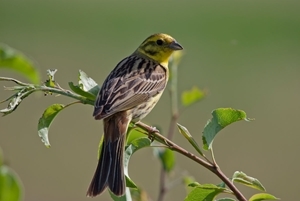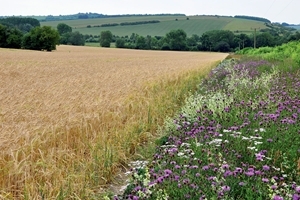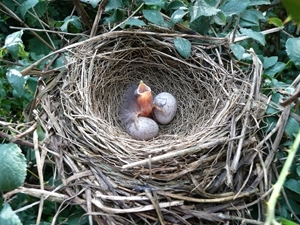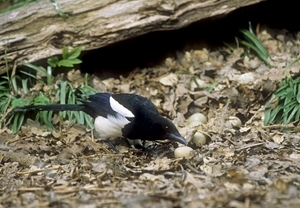Key points
- Agricultural practices have become more intensive, which has contributed to declines in farmland birds such as yellowhammers.
- Yellowhammers are an important farmland bird and are red listed in the UK.
- Scientists studied 147 yellowhammer nests, predator numbers, and agri-environment scheme (AES) habitats at the Allerton Project from 1995-2007.
- Most yellowhammer nests were found near AES habitats, with wild bird seed mix habitats having the biggest impact on breeding success.
- Magpie densities and insect-rich habitat availability did not appear to influence yellowhammer breeding success.
- Winter and spring AES habitats should be sown alongside each other to ensure chick food items are available in high numbers near yellowhammer breeding habitats.
Background
 Over the last several decades, farmland management has become more intensive. This is due to shifts in farming methods such as:
Over the last several decades, farmland management has become more intensive. This is due to shifts in farming methods such as:
- More non-traditional crops being grown
- Increased use of chemicals such as pesticides and herbicides
- Reduction of field margins and other non-cropping areas
These changes occurring at the same time has resulted in declines in arable plants and invertebrates, and has contributed to bird declines, with the number of common farmland birds falling by 50% on average since the 1980s.
Following these declines and concern about the impact of farming on biodiversity, agri-environment schemes (AES) were introduced in England. These government schemes aim to help farmers manage their land in an environmentally friendly way, providing habitats and resources for biodiversity alongside productive land. Schemes vary based on the region, farm type, and species you are trying to benefit. Crop fields often support low levels of invertebrates and seed foods, and so AES habitats in agricultural landscapes can be an important resource for wildlife.
Previous research has looked at the relationship between farmland bird nesting success and habitats, predator numbers, and the amount and type of food available, but no study has considered these factors simultaneously. This study focuses on yellowhammers, a field-boundary nesting species that mainly eat seeds and feed their young invertebrates. Since the 1980s, yellowhammer numbers have declined by 50% across most of Europe, and they are now a UK red listed species. They can search for food up to 300m from their nests but gather 60-90% of food for chicks within the first 100m, collecting spiders, flies, beetles, true bugs, and moths for their chicks. The study aimed to inform future conservation management of this species.
What they did
Scientists analysed a dataset of 147 yellowhammer nests monitored between 1995 and 2007 at the Allerton Project, Leicestershire. The farm there mainly grows crops such as wheat, barley, oats, oilseed rape and field beans. A range of AES habitats have been in place at the Allerton Project since 1993 to try to benefit songbirds and other species, including wildflower margins, conservation headlands, wild bird seed mix (WBSM) strips, beetle banks and grain hoppers for feeding pheasants. Control of Eurasian magpies, carrion crows, red foxes, brown rats, stoats and weasels was conducted between 1993 and 2001, and magpie territories were mapped after this period.
For the study, vegetation types were sorted into five broad categories:
| Habitat category |
Composition |
| Broadleaf |
Oilseed rape, linseed, winter beans and spring beans |
| Cereal |
Winter wheat, winter barley and oats |
| Spring AES |
Grass margins, grass set-aside, beetle banks and conservation headlands |
| Pasture |
Permanent pasture |
| WBSM |
Set-aside strips planted with wild bird seed |
Boundary habitats such as hedgerows and field margins were annually searched for yellowhammer nests between March and August. Nests found during these searches were then checked every three to four days until they succeeded with at least one fledged chick, or failed to fledge any chicks.
In order to try to understand what factors may lead to nest success or failure, the proportion of the five habitat categories within 100m of nests were mapped and related to nest success measures. Nest location, nest predator numbers, and invertebrate abundance were also measured.
What they found
 The scientists found that yellowhammer hatching success varied year on year throughout the 1995-2007 study period. Overall, 116 of the 147 nests found were located near AES habitats. The abundance of chick food was highest in spring AES habitats like beetle banks and conservation headlands, but was lower in cereal crops, permanent pasture, broadleaf crops and WBSM habitats. Abundance of chick food invertebrates declined across the entire farm throughout the study period.
The scientists found that yellowhammer hatching success varied year on year throughout the 1995-2007 study period. Overall, 116 of the 147 nests found were located near AES habitats. The abundance of chick food was highest in spring AES habitats like beetle banks and conservation headlands, but was lower in cereal crops, permanent pasture, broadleaf crops and WBSM habitats. Abundance of chick food invertebrates declined across the entire farm throughout the study period.
Although chick food levels were high in spring AES habitats, the presence of these insect-rich habitats did not influence hatching success, with hatching success declining with increased availability of these habitats. Fledging success also declined when the amount of permanent pasture habitat found within 100m of a nest increased.
Instead, hatching success increased with nest height, and fledging success improved when the amount of WBSM habitat within 100m of a nest increased.
No relationship was found between yellowhammer hatching or fledging success and the density of magpie territories.
What does this mean?
 This study is believed to be the first to recognise the importance of WBSM cover as an important breeding habitat for yellowhammers. Surprisingly, WBSM habitats have similar numbers of insects to areas of broadleaf or cereal crops – which are significantly lower than those found in spring AES habitats. The scientists hypothesise that food may be more accessible for birds in WBSM habitats, or that there may be better shelter from predators in these areas. Alternatively, WBSM habitats may benefit fledging success by improving adult fitness, meaning that they are in good condition for breeding the following spring.
This study is believed to be the first to recognise the importance of WBSM cover as an important breeding habitat for yellowhammers. Surprisingly, WBSM habitats have similar numbers of insects to areas of broadleaf or cereal crops – which are significantly lower than those found in spring AES habitats. The scientists hypothesise that food may be more accessible for birds in WBSM habitats, or that there may be better shelter from predators in these areas. Alternatively, WBSM habitats may benefit fledging success by improving adult fitness, meaning that they are in good condition for breeding the following spring.
Spring AES habitats are designed to be insect-rich, and while this provides food for hungry chicks, it lacks seed resources for adults to feed on. Adults need energy to forage for food for their chicks so a lack of seed resources for them can negatively impact the chicks they are trying to rear. The value of spring AES habitats as insect ‘hotspots’ is also reduced if pesticides that may result in invertebrate declines are used on site, as seen over the study period. Where invertebrates are difficult to find, adults work harder to give their chicks enough food – this puts even more strain on breeding adults and may affect their ability to reproduce and survive.
As well as this, there could be more predation pressure in spring AES habitats, which are typically narrow, linear strips located along field edges. Generalist predators like foxes and badgers are thought to be drawn to these habitats because they provide easy travel routes through landscapes and often host high numbers of rodents. It is not thought that ground nests are sought out by predators, but they are likely consumed when encountered.
 Predation pressure is very likely to affect yellowhammer breeding. Increased nest height leading to better hatching success is an indication that legal control of crows and magpies – which can predate nests found higher off the ground – is beneficial to yellowhammers. That said, no significant relationship was found between the magpie density and yellowhammer breeding success, so more research is needed to investigate this further and look at the impacts of total predation pressure.
Predation pressure is very likely to affect yellowhammer breeding. Increased nest height leading to better hatching success is an indication that legal control of crows and magpies – which can predate nests found higher off the ground – is beneficial to yellowhammers. That said, no significant relationship was found between the magpie density and yellowhammer breeding success, so more research is needed to investigate this further and look at the impacts of total predation pressure.
This study provides the first in-depth analysis of the relative effects of nesting and foraging habitats, predators, and food availability on yellowhammer nest survival. The most important finding from this study is that an AES habitat designed to provision winter bird food, WBSM, appears to also offer benefits in the breeding season. More research is needed to investigate this relationship further, but it is clear that WBSM habitats should be sown alongside insect-rich spring AES habitats where yellowhammers are likely to breed, in order to provide food for both adults and chicks.
Read the original paper
McHugh, N.M., White, P.J.C., Moreby, S.J., Szczur, J., Stoate, C., Leather, S.R., & Holland, J.M. (2022). Linking agri-environment schemes habitat area, predation and the abundance of chick invertebrate prey to the nesting success of a declining farmland bird. Ecological Solutions and Evidence, 3(e12155)